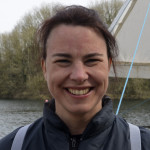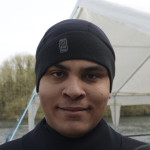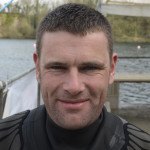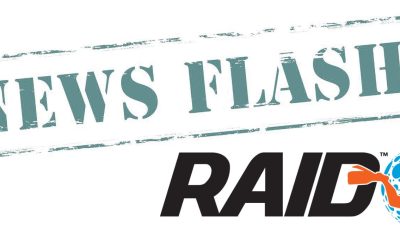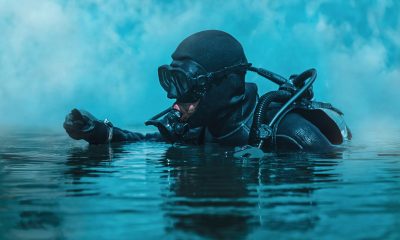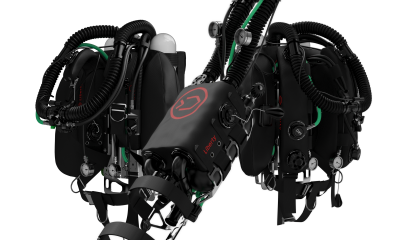News
Becoming a PADI Tech Support Diver

 Cropping up alongside PADI’s growing list of TecRec training courses are a number of distinctive specialties focusing on the more diverse aspects of technical diving. By popular request, Martin Robson, who is one of PADI’s designated instructor trainers, has written a new specialty course to teach the roles and responsibilities of a support diver typically needed on expedition level dives.
Cropping up alongside PADI’s growing list of TecRec training courses are a number of distinctive specialties focusing on the more diverse aspects of technical diving. By popular request, Martin Robson, who is one of PADI’s designated instructor trainers, has written a new specialty course to teach the roles and responsibilities of a support diver typically needed on expedition level dives.
Martin invited me along to inland diving site Vobster Quay to check out his inaugural 2-day course. On a particularly cold, crisp Saturday morning in April I packed up my trusty drysuit complete with newly fitted dry gloves and made tracks for Frome near Somerset. In this instance my job was to observe rather than participate. Martin had pre-warned me that the water temp would be a toe tingling 3 degrees. The support diver specialty course works much better with a team of divers so at least I wasn’t going to be the only numpty braving the elements!
Martin has more than 30 years of diving experience. His long list of credentials include PADI, IANTD, TDI and cave diving agencies up to instructor trainer trimix CCR level. Throughout the years he has planned and executed a substantial amount of wreck and cave expeditions to a maximum depth of 180m which provided the foundation for this course. Martin runs EAU2 Advanced Diver Training as well as organising new expeditions. He conveniently lives just 10 minutes drive from Vobster Quay where most of his tech training work is conducted. Martin huffed and said “I know Vobster far too well.”
I was interested to know what had inspired Martin to write this specific PADI distinctive specialty course in the first place. Martin said he had recently given presentations at Oztek in Sydney, the Polish dive show in Warsaw and at the Eurotek conference on some of his expeditions. There had been a lot of questions from the audience about becoming a support diver, underwater habitats and expedition diving in general so the idea just grew from there. Martin wrote the basic structure of the course in 2 days and then submitted it to PADI for approval. He said “support staff are used in a whole range of roles depending upon the requirements of the particular mission, but common roles include pre-exploration dive equipment preparation and positioning, in-water equipment provisioning during the dives, safety and rescue support, and surface management. Being a support diver is a great way to get involved in expedition diving and gaining experience of the roles and techniques support divers need is both fun and challenging.”
Seven divers turned up for the weekend event which included some theory, a dry practical session and 4 training dives. Minimum certification requirements are PADI rescue diver and Tec Rec 40 or Tec Rec 40 CCR diver with a minimum of 10 dives on whatever rebreather was being used on the course. I noticed that there were plenty of different equipment configurations varying from CCRs to sidemounts. But this course wasn’t about diving deep; in fact, the habitat itself would be anchored to the crushing works at a depth of around 6 metres. The other practical sessions were performed by the plane wreck which is no deeper than 18 metres.
After tea and bacon sandwiches Martin gathered everyone together to talk about the differences between a support diver, a standby diver and a safety diver. We then got our first glimpse of the underwater habitat, which in this case, was a plastic box encompassed in a metal framework roughly 2m long x 1m wide x 2m high, suitable for 2 divers. Martin said he has used much bigger habitats and on one particular expedition it turned out to be too big and got wedged inside the cave entrance!
At this point it’s probably worth explaining what an underwater habitat is actually used for. Martin said that habitats help exploration divers stay warmer and make rehydration easier while decompressing, which is basically the same concept as a diving bell used in commercial saturation diving. But in this case the divers don’t breathe the gas inside the habitat, as this would soon become unbreatheable; instead they breathe from gas mixes that they are either carrying with them, or that are hooked onto the habitat or are being carried by support divers. This obviously varies depending on the dive, location and equipment available. They have exactly the same decompression obligations as being in water – the main difference is that the divers can surface inside an air pocket, which just makes life a bit more comfortable.
For Dive 1 ‘Team Robson’ assembled on the platform and lowered the habitat into the water. This was towed into position over to the top of crushing works and sunk. The whole operation required some nifty teamwork skills, especially during the underwater anchoring and making buoyant phases. Untangling the underwater comms cable proved to be the most taxing part of the day. The idea was to have a telephone system connecting surface support to the divers inside the habitat, but the unit was playing up and eventually got packed away. Dive 2 focused more on supporting the lead diver. This time, in teams of 2, the task was to unclip and exchange all 4 stage cylinders attached to Martin, which turned out to be a lot more fiddly than expected. One of the divers managed to lose his torch during all the fun and games so Dive 2 was rounded off with an additional search and recovery exercise. Being a support diver requires many different skills!
On Sunday morning I managed to jump in with Martin and Graham Allathan (who has been a support diver on a number of Martin’s previous expeditions) to get a few undisturbed underwater pictures of the habitat. Visibility was at best 3 or 4 metres but at least Martin and Graham were using rebreathers so there were no exhaled bubbles to worry about, although the floaty mouthpiece of Graham’s twin rebreather unit looked slightly out of place.
By the time we surfaced the rest of the team were kitted up and ready for Dive 3, which involved looking after lead diver Martin while he was decompressing inside the habitat. This included monitoring gas supplies, changing cylinders and battery packs, supplying food and drink etc. Everybody then got the chance to surface inside the habitat, have a drink, eat some food and do a simulated gas exchange. The final dive was basically the reverse of dive 1 so the habitat was brought to the surface in a controlled manner and towed back to the platform. At the end of a very full on weekend I sat down with Martin to get his thoughts on the very first support diver distinctive specialty course. He said ‘‘I thought the course went extremely well. It was nice to see everyone having fun and learning at the same time.”
Martin’s main passion is cave exploration and I think this is where underwater habitats are best suited. From my own perspective it was great to see a group of individual divers interacting and working together as a team. Exchanging cylinders, getting used to clips, D-ring positions etc is definitely a useful skill to practice. I haven’t had any experience with major expeditions involving a team of divers, so Martin’s support diver course gave me a good idea of what to expect. I think one of Martins own blog comments summed up the weekend quite nicely – when asked what attributes do you look for in an expedition diver, Martin said “I look for a team player who shares the team philosophy and goals, who is self disciplined, works hard and who can be relied upon when the chips are down but also knows when to have fun.”
—————————————————————————————————————————————————————————
Course comments
From: Weston Supermare
Level: TDI trimix, PADI Instructor
Dives: 700
“The course was a fascinating insight into what goes into supporting expedition level diving. The weekend was interesting, challenging and immense fun all at the same time.”
From: Bristol
Level: TDI Instructor, PADI Instructor
Dives: 800
“Overall I thought it was a good opportunity to learn from someone who has done real expeditions. I picked up some great tips. I would love to get involved with real life expeditions.”
From: Liverpool
Level: PADI tec 40, BSAC advanced diver
Dives: 400
“First enjoyable weekend I have had since I got back into diving. Brilliant exercise in teamwork. It’s given me a major insight into expedition planning and training.”
From: Swindon
Level: IANTD CCR Mod 1
Dives: 500
“It was me that actually asked for the specialty in the first place! I spoke to Martin at the Eurotek show after his talk on the blue lakes project. I wanted to get an understanding of what’s required of a support diver and so Martin set up the PADI distinctive specialty.
“I thought the weekend was excellent fun, well organised and gave me a great insight into being both shore and underwater expedition diving. The course will benefit any tech diver in terms of practice and skills.”
From: London
Level: PADI Divemaster, IANTD ART
Dives: 215
“I learnt some amazing things that I don’t usually think about. Clipping off cylinders is completely different when you are doing it on someone else. I loved the teamwork aspect and the application of existing skills but in a different way.”
From: Bournemouth
Level: IANTD, BSAC Club Instructor
Dives: 300
“Great fun weekend. It’s given me a small glimpse into the logistics, skills and teamwork of an expedition.”
From: Scotland
Level: IANTD CCR trimix
Dives: 1000 plus
“I’m the whipping boy! I wanted to learn more about habitats, practice for real and do some experimentation to set up properly.”
—————————————————————————————————————————————————————————
It was a pretty good course. You can read all the theory but it’s different in practice. It was nice to see everyone enjoying the weekend. There’s a much better atmosphere with groups.
To find out more about the technical diving courses that Martin offers visit www.eau2.com.
Discuss this article in the Scubaverse Forum.
Gear News
Scubapro Free Octopus Promotion 2024

Free Octopus with every purchase of a SCUBAPRO regulator system
Just in time for the spring season, divers can save money with the FREE OCTOPUS SPRING PROMOTION! Until July 31st SCUBAPRO offers an Octopus for free
with every purchase of a regulator system!
Get a free S270 OCTOPUS with purchase of these combinations:
MK25 EVO or MK19 EVO with A700
MK25 EVO or MK19 EVO with S620Ti
MK25 EVO or MK19 EVO with D420
MK25 EVO Din mit S620Ti-X
Get a free R105 OCTOPUS with purchase of the following combinations:
MK25 EVO or MK19 EVO with G260
MK25 EVO or MK17 EVO with S600
SCUBAPRO offers a 30-year first owner warranty on all regulators, with a revision period of two years or 100 dives. All SCUBAPRO regulators are of course certified according to the new European test standard EN250-2014.
Available at participating SCUBAPRO dealers. Promotion may not be available in all regions. Find an authorized SCUBAPRO Dealer at scubapro.com.
More information available on www.scubapro.com.
Blogs
Northern Red Sea Reefs and Wrecks Trip Report, Part 3: The Mighty Thistlegorm

Jake Davies boards Ghazala Explorer for an unforgettable Red Sea diving experience…
Overnight, the wind picked up, making the planned morning dive a bit bumpy on the Zodiacs to the drop point on Thomas Reef. There, we would dive along the reef before descending through the canyon and then passing under the arch before ascending the wall with a gentle drift. The site provided great encounters with more pelagic species, including shoals of large barracuda, tuna, and bigeye trevally.
Once back on the boat, it was time to get everything tied down again as we would head back south. This time, with the wind behind us, heading to Ras Mohammed to dive Jackfish Alley for another great gentle drift wall dive before then heading up the coast towards the Gulf of Suez to moor up at the wreck of the Thistlegorm. This being the highlight wreck dive of the trip and for many onboard, including myself, it was the first time diving this iconic wreck. I had heard so much about the wreck from friends, and globally, this is a must on any diver’s list. Fortunately for us, there was only one other boat at the site, which was a rarity. A great briefing was delivered by Ahmed, who provided a detailed background about the wreck’s history along with all the required safety information as the currents and visibility at the site can be variable.

Kitting up, there was a lot of excitement on deck before entering the water and heading down the shoreline. Descending to the wreck, there was a light northerly current which reduced the visibility, making it feel more like the conditions that can be found off the Welsh coast. At 10m from the bottom, the outline of the wreck appeared as we reached the area of the wreck which had been bombed, as our mooring line was attached to part of the propeller shaft. Arriving on deck, instantly everywhere you looked there were many of the supplies which the ship was carrying, including Bren Carrier tanks and projectiles that instantly stood out.

We headed around the exterior, taking a look at the large propeller and guns mounted on deck before entering the wreck on the port side to take a look in the holds. It was incredible to see all the trucks, Norton 16H, and BSA motorcycles still perfectly stacked within, providing a real snapshot in time.

Overall, we had four dives on the Thistlegorm, where for all of the dives we were the only group in the water, and at times, there were just three of us on the whole wreck, which made it even more special, especially knowing that most days the wreck has hundreds of divers. Along with the history of the wreck, there was plenty of marine life on the wreck and around, from big green turtles to batfish, along with shoals of mackerel being hunted by trevally. Some unforgettable dives.

The final leg of the trip saw us cross back over the Suez Canal to the Gobal Islands where we planned to stay the night and do three dives at the Dolphin House for the potential of sharing the dive with dolphins. The site, which included a channel that was teeming with reef fish, especially large numbers of goatfish that swam in large shoals along the edge of the reef. These were nice relaxing dives to end the week. Unfortunately, the dolphins didn’t show up, which was okay as like all marine life they are difficult to predict and you can’t guarantee what’s going to be seen. With the last dive complete, we headed back to port for the final night where it was time to clean all the kit and pack before the departure flight the next day.

The whole week from start to finish on Ghazala Explorer was amazing; the boat had all the facilities you need for a comfortable week aboard. The crew were always there to help throughout the day and the chefs providing top quality food which was required after every dive. The itinerary providing some of the best diving with a nice mixture of wreck and reef dives. I would recommend the trip to anyone, whether it’s your first Red Sea liveaboard in the Red Sea or you’re revisiting. Hopefully, it’s not too long before I head back to explore more of the Red Sea onboard Ghazala Explorer.

To find out more about the Northern Red Sea reef and wrecks itineraries aboard Ghazala Explorer, or to book, contact Scuba Travel now:
Email: dive@scubatravel.com
Tel: +44 (0)1483 411590
Photos: Jake Davies / Avalon.Red
-

 News3 months ago
News3 months agoHone your underwater photography skills with Alphamarine Photography at Red Sea Diving Safari in March
-

 News3 months ago
News3 months agoCapturing Critters in Lembeh Underwater Photography Workshop 2024: Event Roundup
-

 Marine Life & Conservation Blogs2 months ago
Marine Life & Conservation Blogs2 months agoCreature Feature: Swell Sharks
-

 Blogs2 months ago
Blogs2 months agoMurex Resorts: Passport to Paradise!
-

 Blogs2 months ago
Blogs2 months agoDiver Discovering Whale Skeletons Beneath Ice Judged World’s Best Underwater Photograph
-

 Marine Life & Conservation2 months ago
Marine Life & Conservation2 months agoSave the Manatee Club launches brand new webcams at Silver Springs State Park, Florida
-

 Gear Reviews3 months ago
Gear Reviews3 months agoGear Review: Oceanic+ Dive Housing for iPhone
-

 Gear Reviews2 weeks ago
Gear Reviews2 weeks agoGEAR REVIEW – Revolutionising Diving Comfort: The Sharkskin T2 Chillproof Suit













